Medical supply marketplaces greatly rely on fast performance, where inventory data has to be accurate to the last minute detail. Although existing practices in managing inventory data can get the work done, they often lack the effectiveness that AI provides.
In this piece, we’ll look into how AI tools can improve your medical supply marketplace’s flow, smart inventory system management, and general processes. We’ll see some positive impacts it can have, as well as ways and handy tips for implementing it.
Understanding AI's impact on healthcare supply chains
You can often hear that “AI is revolutionizing” something, be it a marketplace, a SaaS solution, or a mobile app. In fact, it’s not an overstatement, as AI utilizes a variety of algorithms based on existing data to provide the most accurate and relevant results about whatever it is working on.
Unlike AI in the healthcare supply chain, traditional supply chains often struggle with stockouts, over-ordering, and inefficiencies that can impact patient care. AI-driven solutions address these challenges and provide real-time insights and automated decision-making. Apparently, there’s more to it than meets the eye, so let’s take a closer look at how important smart inventory management is in medical supply marketplaces.
The importance of smart inventory management in medical supply marketplaces
Challenges in traditional inventory management
In healthcare, stock availability directly impacts healthcare providers, patient care, and how smooth operations are. Marketplaces that still manage medical supplies manually or with outdated systems often risk creating dozens of inefficiencies, huge shortages, and financial losses, both for themselves and for their clients. Apart from this, some of the most common challenges are:
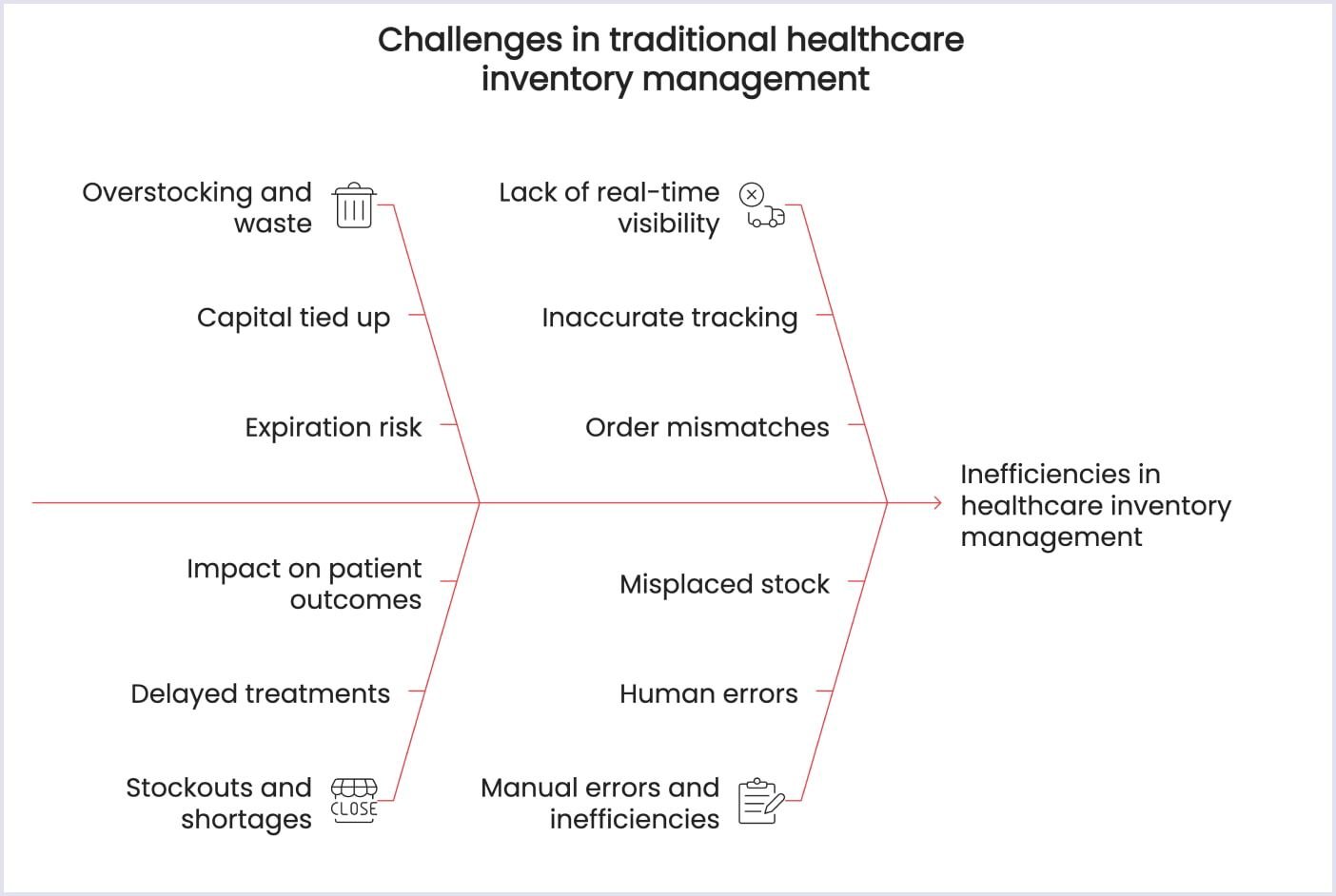
- Overstocking and waste. Excess inventory ties up capital and increases the risk of product expiration, leading to waste and financial loss.
- Stockouts and shortages. Critical medical supplies running out can delay surgeries, treatments, and emergency care, impacting patient outcomes.
- Lack of real-time visibility. Without real-time updates, inventory tracking is inaccurate, leading to delayed restocking and order mismatches.
- Manual errors and inefficiencies. Paper-based or manual systems are prone to human errors, miscounts, and misplaced stock, making it harder to maintain accurate inventory records.
- Regulatory compliance challenges. Medical supplies require strict documentation of expiration dates, usage logs, and storage conditions to meet industry regulations.
- Disrupted supply chains. Delays in supplier deliveries, global supply chain disruptions, and logistics issues make it harder to maintain a steady stock of critical products.
How AI enhances inventory management
The majority of challenges mentioned above can be prevented or negated thanks to AI-powered integrations. They improve inventory management in a number of ways, all by analyzing demand patterns, updating stock levels, and automating replenishment processes. Here are several ways AI can solve common inventory management issues previously listed:
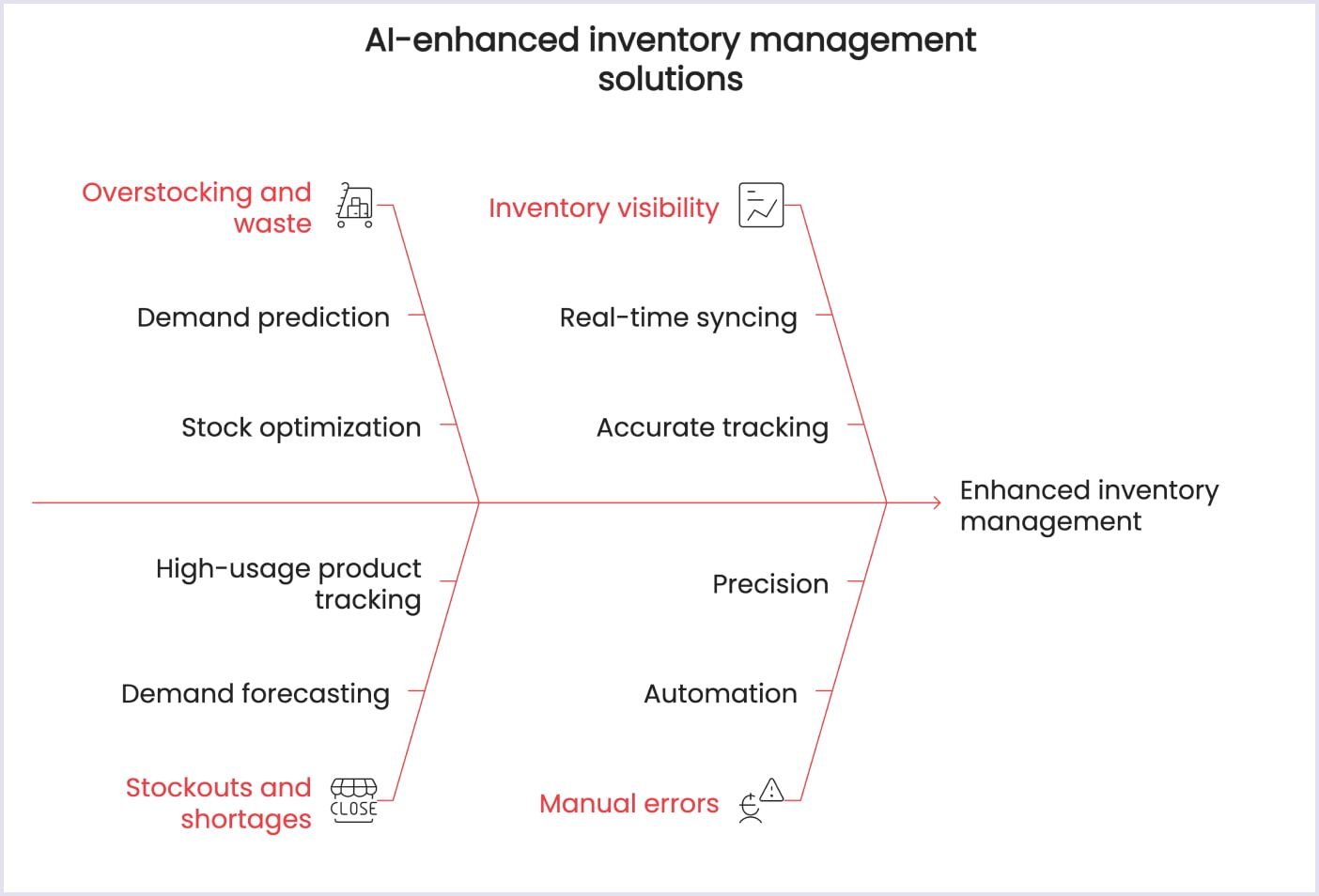
- Prevents overstocking and waste. AI predicts demand fluctuations and optimizes stock levels to reduce excess inventory and prevent expiration-related losses.
- Reduces stockouts and shortages. AI-driven demand forecasting ensures that high-usage medical products remain stocked and prevents treatment delays and patient care disruptions.
- Provides real-time inventory visibility. AI syncs stock levels instantly across all suppliers and warehouses to provide accurate, up-to-date inventory tracking.
- Eliminates manual errors. As AI automates inventory tracking, it greatly minimizes human errors, miscounts, and misplaced stock. This makes inventory management more precise and efficient.
- Enhances regulatory compliance. AI monitors product expiration dates, storage conditions, and documentation requirements to make up for compliance with industry regulations.
- Strengthens supply chain. AI helps marketplaces predict and adapt to supply chain disruptions, optimizing procurement and ensuring consistent stock flow.
Read also: How to Launch a Successful Medical Supply Marketplace: A Step-by-Step Guide
AI-powered demand forecasting in medical supply marketplaces
The need for accurate demand forecasting
Accurate demand planning in healthcare is essential in medical supply marketplaces. It directly impacts the availability of critical products. Poor demand predictions can lead to supply shortages, which disrupt healthcare services or overstocking.
Same as with inventory, traditional forecasting methods rely heavily on historical sales data and manual calculations. Surely, these approaches provide some insight, but they often fail to account for sudden demand shifts or supply chain issues.
Without real-time medical supply chain analytics and automated adjustments, marketplaces risk making misguided procurement decisions that can impact both profitability and patient care. Besides, other challenges in traditional demand forecasting often include:
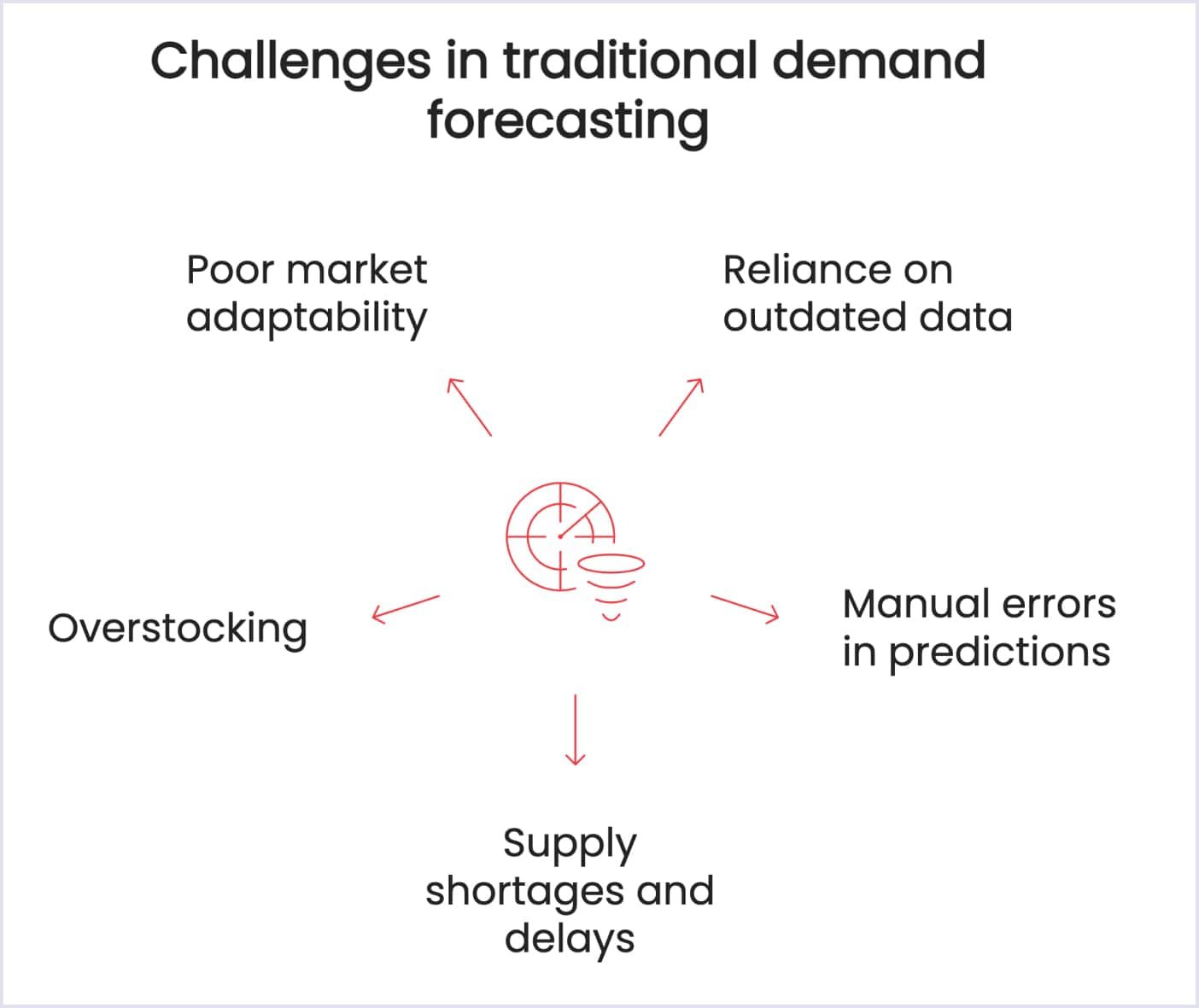
AI techniques for demand forecasting
AI-powered demand forecasting eliminates the challenges mentioned earlier as it uses advanced data calculation algorithms, real-time tracking, and predictive modeling to optimize supply chain management. Unlike manual forecasting, AI continuously learns and adjusts based on live data, trends, and external influences. As such, key AI-driven benefits include:
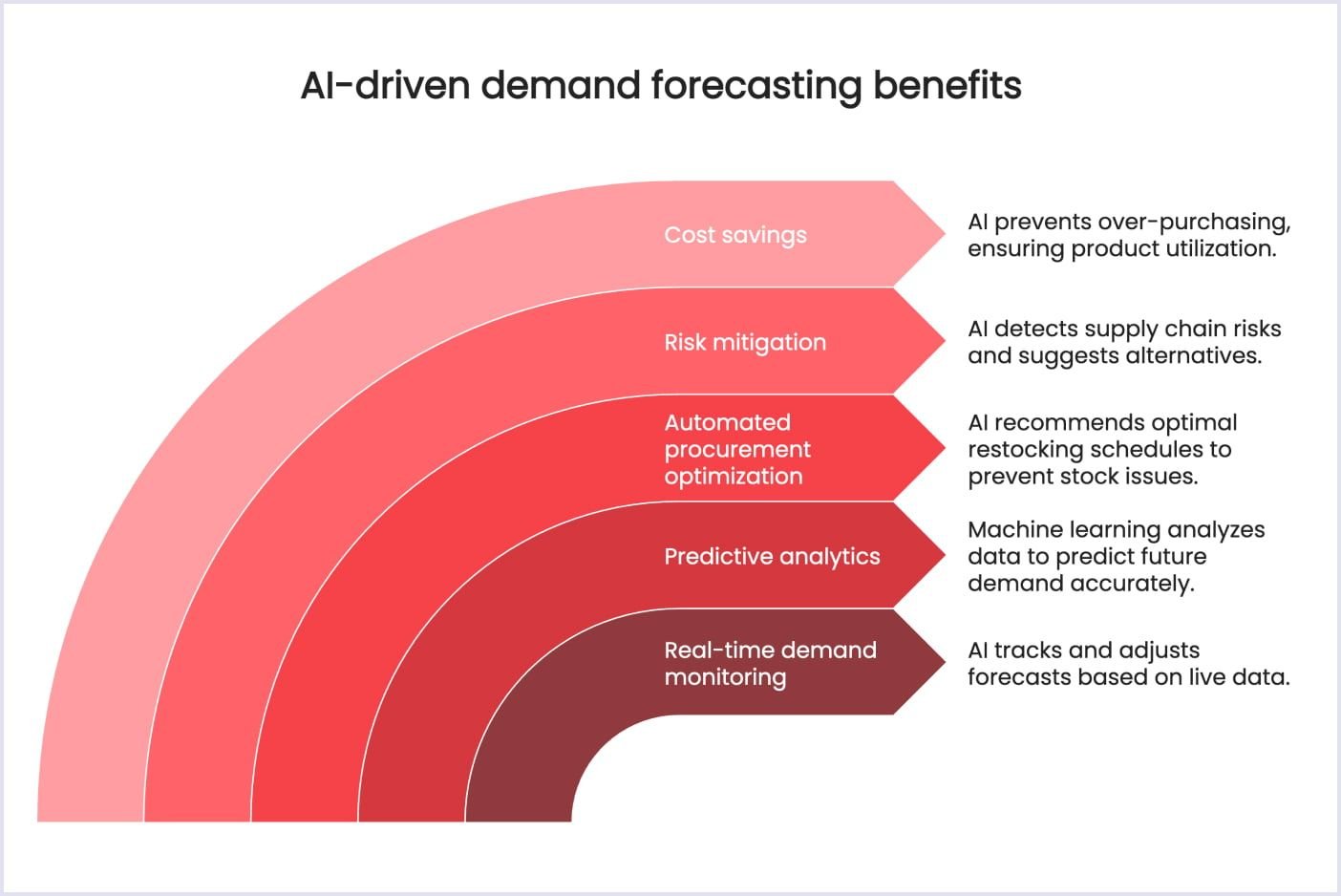
- Real-time demand monitoring. AI tracks real-time supply trends and customer demand, adjusting forecasts dynamically.
- Predictive analytics in healthcare for future demand. Machine learning algorithms for demand forecasting analyze historical data, seasonal trends, and market fluctuations to generate highly accurate data predictions.
- Automated procurement optimization. AI recommends optimal restocking schedules to prevent both stockouts and overstocking.
- Risk mitigation for supply chain issues. AI detects potential supply chain risks and suggests alternative suppliers and inventory adjustments.
- Cost savings. AI prevents unnecessary over-purchasing, ensuring medical products are utilized before expiration.

Implementing AI in medical supply marketplaces: a step-by-step guide
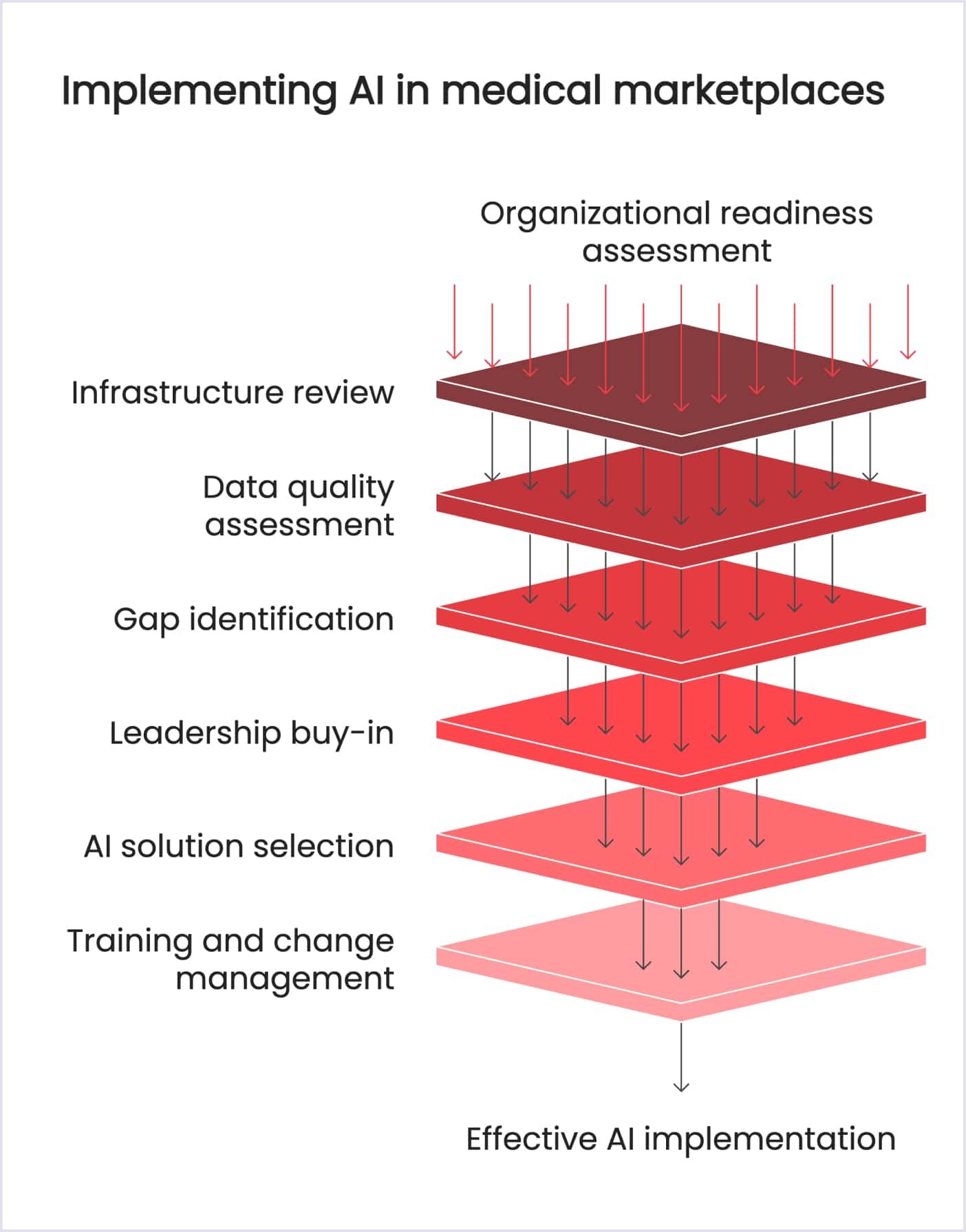
Assessing organizational readiness
Before implementing AI, it’s essential to evaluate whether your existing marketplace infrastructure is ready for technological transformation. This often involves:
- Reviewing existing infrastructure, APIs, and architecture to ensure compatibility with AI-driven tools. They should have enough space and data to work with;
- Assessing data quality and its organization. AI systems rely on clean, structured data for accurate predictions;
- Identifying gaps in current inventory management and supply chain processes where AI can bring measurable improvements;
- Ensuring leadership and stakeholder buy-in to support AI adoption across all departments.
Selecting appropriate AI solutions
There’s a myriad of AI tools available in the market. Choosing the right ones depends on business needs, scalability, and system compatibility. When selecting AI-driven solutions, it’s advisable to consider:
- Scalability. Can the AI system grow with the business and handle increasing data loads?
- Integration capabilities. How well does the AI tool connect with existing inventory management, ERP, and logistics platforms?
- Functionality. Does the AI solution support real-time inventory tracking, demand forecasting, and automated decision-making?
- Regulatory compliance. Can AI systems adhere to industry regulations that are crucial for medical supply marketplaces?
Read also: AI-Powered Product Matching for Medical Equipment: Connecting Buyers with the Right Vendors
Training and change management
AI implementation is not just a small integration but rather an organizational transformation that affects many aspects of your marketplace. Apart from setup processes, it also requires proper training and changes in management strategies, so that all users understand and utilize AI effectively. Speaking of the marketplace management staff, in particular, you should:
- Provide hands-on training sessions for employees to familiarize them with AI tools;
- Develop guidelines and best practices for AI-driven decision-making;
- Encourage collaboration between IT teams and operational staff to troubleshoot integration issues;
- Monitor system performance and gather feedback to refine AI applications over time.
Future trends in AI for medical supply marketplaces
AI evolves at a fast pace and offers greater efficiency, accuracy, and automation in medical supply marketplaces. Advancements in deep learning, natural language processing (NLP), and computer vision allow businesses to automate complex tasks, optimize supply chains, and improve decision-making.
NLP and chatbots
NLP-powered AI chatbots and virtual assistants are already streamlining supplier communications, automated order processing, and customer support. However, as these systems advance, they become more accessible, offering:
Human-oriented, conversational AI for seamless human-like interactions; Multi-language support, allowing global suppliers and customers to communicate more efficiently; Automated supply order tracking, product inquiries, and delivery notifications.
Read also: How to Build Your Own AI Chatbot in 2025: The Ultimate Guide
Image recognition and computer vision
To improve product authentication, AI-powered image recognition and computer vision are becoming irreplaceable tools, thanks to their quality control capabilities and compliance monitoring.
As time goes on, they become more advanced in automatically verifying packaging, expiration dates, and serial numbers. In this process, they can flag counterfeit or defective medical supplies before they reach customers while also automating warehouse management and boosting inventory tracking.
Predictive analytics for inventory and healthcare supply chain optimization
As AI models feed on more data, the level of precision in their predictive analytics becomes even more accurate. With this innovation, marketplaces can more accurately anticipate seasonal and emergency demand fluctuations with minimal human intervention.
In doing so, the AI tools you implement can always optimize inventory distribution, ensuring supplies reach the right locations at the right time.
AI-driven sustainability and waste reduction
Future AI applications will also contribute to sustainability efforts by optimizing inventory levels to minimize waste. AI can help medical suppliers implement efficient redistribution strategies to reduce unnecessary waste and improve cost savings by:
- Identifying slow-moving stock and redistributing it to areas of higher demand.
- Predicting expiration risks to prevent waste of critical medical supplies.
- Enhancing supply chain transparency, ensuring sustainable sourcing and ethical procurement.
Read also: B2B vs B2C Medical Supply Marketplaces: Which Model Works Best?
Bottom line
As AI advances, it brings tons of benefits to the table. The only thing left to do is to find an approach to implement them in your solution. Nowadays, the global market offers a huge catalog of tools, and it can be challenging to choose, implement, and test them.
For this reason, you can refer to our marketplace development services, as the Codica team has been building marketplaces for quite some time now. We offer a range of services covering all aspects of modern marketplace development. Thus, feel free to contact us, and in the meantime, you can browse our portfolio to see what we already accomplished.
